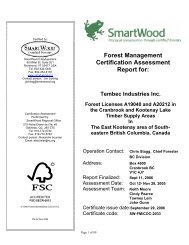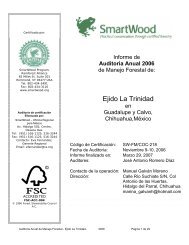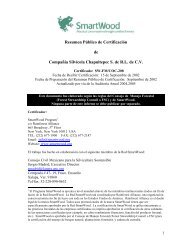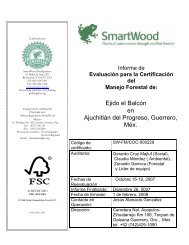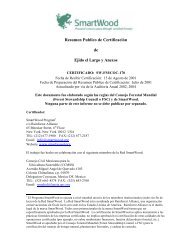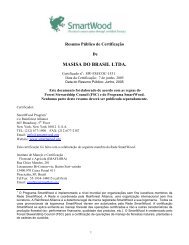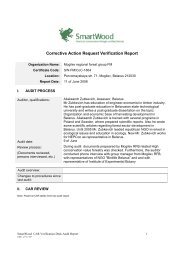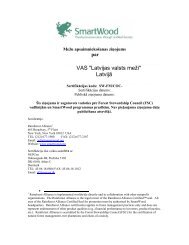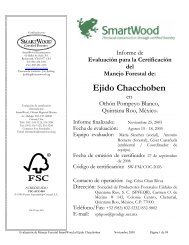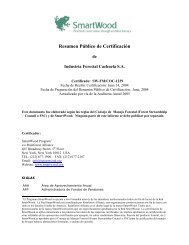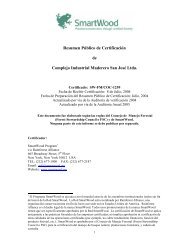[C] The Hidden Frontier of Forest Degradation - Rainforest Alliance
[C] The Hidden Frontier of Forest Degradation - Rainforest Alliance
[C] The Hidden Frontier of Forest Degradation - Rainforest Alliance
You also want an ePaper? Increase the reach of your titles
YUMPU automatically turns print PDFs into web optimized ePapers that Google loves.
ox three » community-based forest management<br />
Community-owned and managed forests comprise significant portions <strong>of</strong> a wide variety <strong>of</strong> forest ecosystems, constituting 11 percent <strong>of</strong><br />
global forest cover (White and Martin, 2002). <strong>The</strong> worldwide amount <strong>of</strong> forest land under Community <strong>Forest</strong> Management (CFM) doubled<br />
between 1985 and 2000 (White and Martin, 2002) and is expected to continue increasing due to global attention to rural land<br />
tenure rights. By 2015, the percentage <strong>of</strong> forest land under CFM is expected to increase to 1.36 billion hectares or 22 percent <strong>of</strong> the<br />
world’s forests (ITTO, 2007). In developing countries alone, 22 percent <strong>of</strong> the forest area is already under CFM (White and Martin<br />
2002), nearly three times the area under private or corporate management. Due to the large and increasing footprint <strong>of</strong> CFM, strategies to<br />
avert degradation will require engagement with the people who live in these forests and the communities that own and manage them.<br />
Limited existing data suggest that CFM outcomes — even in the absence <strong>of</strong> an existing REDD mechanism that supports CFM-based<br />
actions — are highly compatible with averting degradation. In Nepal, CFM is associated with improved forest condition and biodiversity<br />
value, along with increased production <strong>of</strong> firewood, timber, fodder and non-timber forest products; degradation has been reversed and<br />
carbon continues to accumulate in forests under CFM (Karky and Skutsch, 2009). In 20 case studies from around the world the<br />
International Tropical Timber Organization (ITTO) documented that CFM was associated with numerous outcomes that help avert forest<br />
degradation, frequently including improved fire reporting and control, suppression <strong>of</strong> agricultural clearing, and reduction <strong>of</strong> illegal logging<br />
(ITTO, 2007). Murdiyarso and Skutsch (2006) report on a variety <strong>of</strong> CFM projects around Africa and Asia, documenting increases<br />
in carbon sequestration as a result <strong>of</strong> CFM from one to five MgC per hectare per year.<br />
Intentional actions to avert degradation via CFM are likely to be cost effective under some circumstances. Two studies looked at the<br />
potential for CFM to deliver carbon sequestration through improved forest management. Karky and Skutsch (2009) found in the<br />
Himalaya region <strong>of</strong> Nepal that if traditional forest uses (such as fuelwood collection, fodder, limited timber extraction and extraction <strong>of</strong><br />
non-timber forest products) are allowed to continue, then CFM in Nepal can deliver carbon sequestration at an opportunity cost <strong>of</strong><br />
$2.0 to $13.6 per MgC. If all extractive uses are banned, the values rise to an opportunity cost <strong>of</strong> $32.8 to $63.9 per MgC. In Mexico,<br />
De Jong and his co-authors (2000) reported that improved community forest management could deliver substantial sequestration<br />
benefits at carbon prices <strong>of</strong> $15 per MgC.<br />
Achieving avoided emissions from degradation via CFM requires intensive investment in capacity building in multiple communities (De<br />
Jong et al., 2000). Training in basic business management, marketing, forestry, fire management and a variety <strong>of</strong> other disciplines may<br />
be necessary. Equipment needs for monitoring and patrolling must be met. Regional and global mechanisms may be needed to support<br />
CFM and provide market access for forest-based products from small enterprises scattered through remote geographies. Much <strong>of</strong><br />
this same level <strong>of</strong> engagement with communities is likely needed in order to reduce degradation, even in the absence <strong>of</strong> a CFM focus,<br />
with REDD activities (P<strong>of</strong>fenberger and Smith-Hanssen, 2009).<br />
During the development <strong>of</strong> the Kyoto treaty there were repeated calls for the Clean Development Mechanism to support CFM as an<br />
eligible activity to produce carbon <strong>of</strong>fsets (De Jong et al., 2000; Klooster and Masera, 2000). Today, the evidence supporting inclusion<br />
<strong>of</strong> CFM under a REDD mechanism is stronger and the increase in area <strong>of</strong> the world’s forests under CFM makes finding a strategy for<br />
its inclusion even more important.<br />
T H E H I D D E N F R O N T I E R O F F O R E S T D E G R A D A T I O N $ 29


![[C] The Hidden Frontier of Forest Degradation - Rainforest Alliance](https://img.yumpu.com/30611265/33/500x640/c-the-hidden-frontier-of-forest-degradation-rainforest-alliance.jpg)
